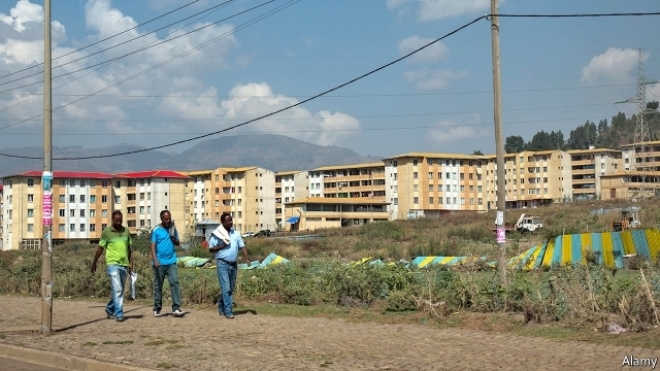
Sunday September 3, 2017

ELEVEN years ago Elsa, a middle-aged widow, won the lottery. The prize was not cash, but the deed to a spacious, three-bedroom flat in Addis Ababa, the capital of Ethiopia. Today she lives there with her four adult children. The deed, now laminated, hangs proudly on her wall.
Elsa is a beneficiary of Ethiopia’s public-housing scheme, one of the most ambitious in Africa. Since it began in 2006, some 250,000 flats have been built and transferred to people in Addis Ababa and other towns. Like Elsa, they are nearly all winners of a computerised lottery, which allocates flats as they become available. The government aims to build 50,000 a year in the capital over the next decade.
In theory, the programme should just about pay for itself. All land in Ethiopia is state-owned, which reduces upfront costs. Beneficiaries make a down payment to the government ranging from 10% to 40% of the price of the flat, which is set by the state. They then pay off the rest over a ten- to 20-year period. A state-owned bank holds the mortgage, providing generous terms.
But the prices charged by the government were too low to sustain the programme. So it has had to hike them. Now poor Ethiopians cannot afford the down payments for even the most subsidised units. Those who can often struggle to pay their mortgages. Many opt to rent out the flats and move elsewhere.
In the face of this fiscal reality, the government has changed its focus. In 2013 it introduced a scheme explicitly aimed at the middle class—those who could afford down payments of 40%—and announced that people who had saved the whole price of the property would skip the lottery and head to the front of the queue. While waiting, applicants have to keep putting money into a savings account. If they stop, they are tossed off the list, further weeding out the poor.
Ethiopia is not alone in its struggles. Public-housing programmes have a long history of failure in Africa. They have often focused on large-scale developments on the edges of cities—and proven unaffordable. A recent project on the outskirts of Luanda, the capital of Angola, offers flats starting at $84,000 in a country where the per capita income is just over $6,000 and the median is far lower. In Cameroon the government’s flagship housing programme is out of reach for 80% of the population, says the World Bank. South Africa has built some 3m houses since 1994, which are doled out free of charge, but most are in poor shape.
Officials in Ethiopia talk of moving away from public provision and of allowing foreign firms to participate in the housing scheme. To aid the poor, analysts recommend that the government give them land and help them to build their own homes. Boosting the amount of land available to private developers might also help. Because the government keeps a tight grip on supply, the price of land is steep. In the commercial centre of Addis Ababa a lease can now cost as much as $15,000 per square metre.
Despite the high prices, demand for public housing continues to rise. When a second round of registration for the homes opened in 2013 over 1m people, including Elsa’s 25-year-old daughter, Miqnay, signed up.
But many have given up hope. Elsa doesn’t expect Miqnay to receive a flat within the next decade. Thousands who registered back in 2005 are still waiting. “Twelve years really is a joke,” says an exasperated employee at the official centre for commerce in Addis Ababa. “Everybody has concluded that the government cannot do it anymore.”